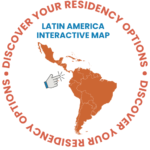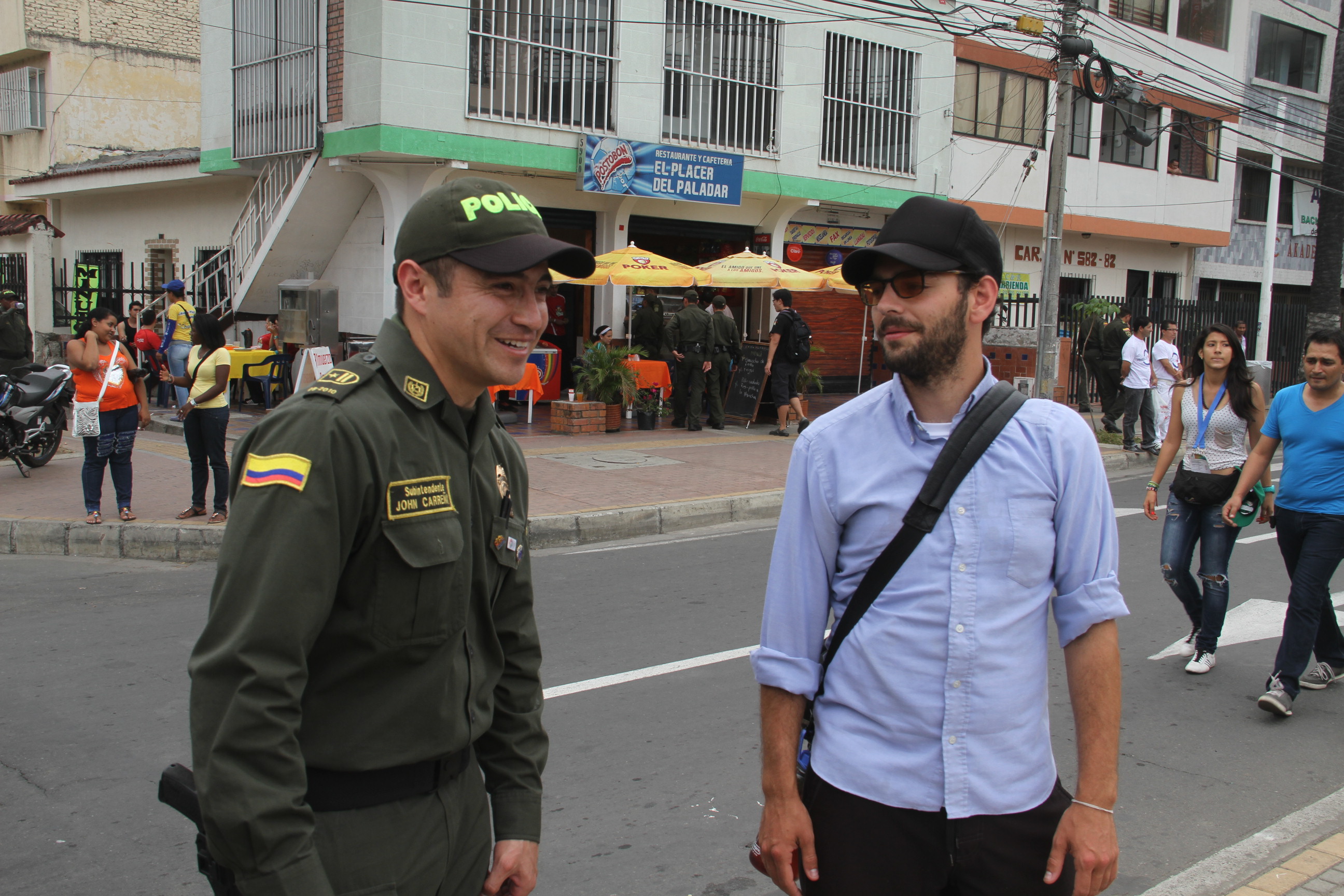LATIN AMERICA
15 min read
This peaceful sunset scene—a family walking barefoot along a quiet Latin American beach—tells a different story than the headlines. Beyond the fear-mongering, there are safe, welcoming, and family-friendly places across the region that rarely make the news.
……………………………..
Thinking about safety in Latin America before making a move? Smart. But let’s question the narrative—why does this diverse region so often get painted with a broad brush of danger?
The short answer: crime headlines.
Stories about drug cartels, gang violence, and corruption dominate international news cycles, creating a skewed image that Latin America is inherently unsafe.
But that’s not the full picture.
In truth, safety in Latin America varies dramatically by country, city, and even neighborhood. While some areas do struggle with real issues, many parts of the region are peaceful, stable, and welcoming.
Countries like Uruguay and Costa Rica consistently rank as safer options, while places like Brazil or certain regions of Mexico face more serious security concerns—but even there, expat-friendly zones exist.
So what’s myth and what’s reality? Let’s break it down and take a closer look at what safety in Latin America really looks like—beyond the headlines.
Table of Contents
1. Safety in Latin America: A Second Look at the Truths
Safety issues are something every country faces even the United States. When comparing the U.S. to Latin America, you’ll find that some areas in both regions can be equally dangerous, while others are just as safe. In fact, many Americans who have moved to Latin America often say they feel safer there than they did back home.
The U.S. also has its own share of safety concerns, such as mass shootings, gun violence, and police brutality, which have been ongoing issues for years. Additionally, with its large and diverse population, safety in Latin America can vary greatly from one place to another.
Some cities, like New York and Chicago, have higher crime rates, while many rural areas experience little to no crime at all. This is like Latin America, where certain cities and regions are known for being safe, while others struggle with higher crime rates.
The important thing is to be aware of the safety concerns specific to each area and to avoid places that are considered risky by locals. With a bit of research, preparation, and common sense, you’ll be able to enjoy a safe and fulfilling experience as an expat living or traveling in Latin America.
To help provide a clearer picture, we’ve included a chart below that ranks the safety of cities in the U.S., Canada, and Latin America, starting with the safest cities at the top. This breakdown will give you a better understanding of how different regions compare in terms of safety.
By looking at these rankings, you’ll be able to see how various cities measure up against each other and get a better sense of what to expect when it comes to living in or visiting these areas.
Whether you’re considering a move or just curious, this list is a great tool to help you understand the differences.
The headlines often overlook what actually draws people here in the first place. From community to climate, there are real advantages to living in Latin America that deserve attention too.
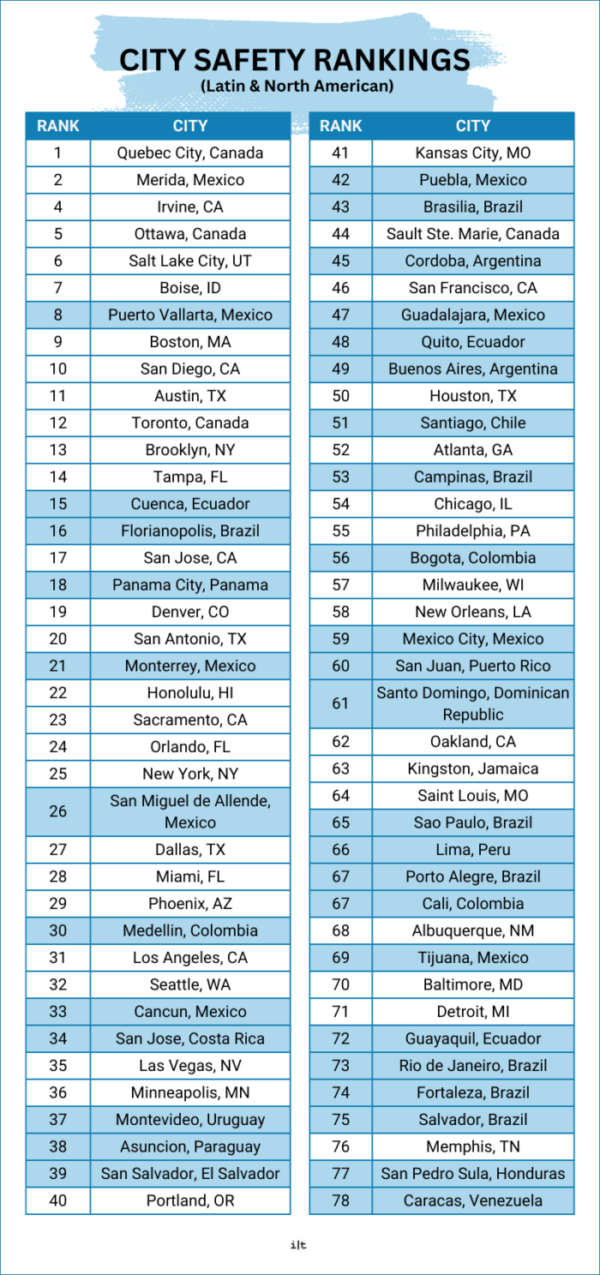
Explore the safety rankings of cities in the US, Canada, and Latin America.
2. Safety in Latin America: Country-by-Country Rankings
To give you a better picture, this map based on the U.S. State Department shows safety levels in different regions of Latin America.
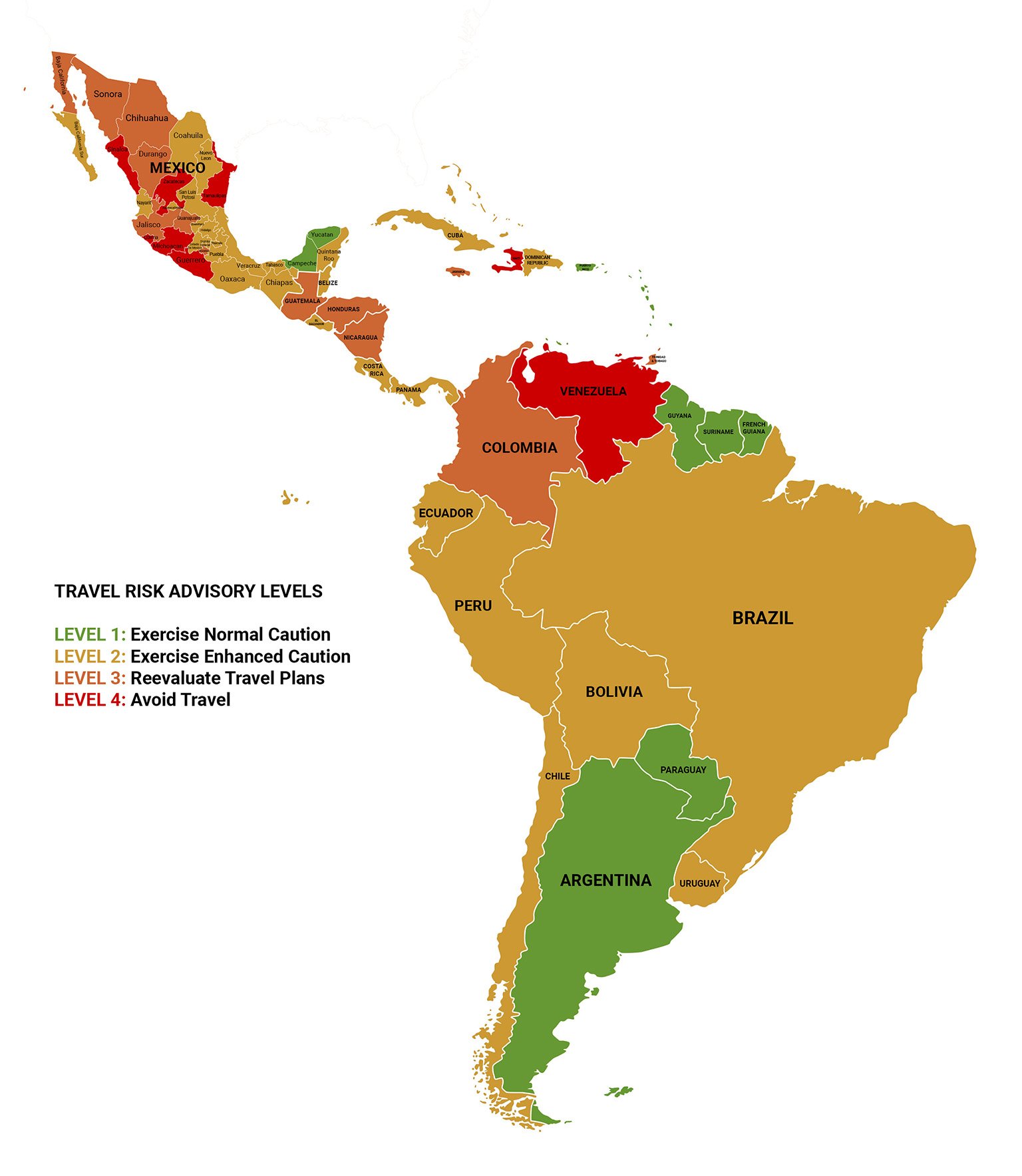
See how safety rates compare across different regions.
As you can see, countries like Brazil and Ecuador are classified as Level 2 – “Exercise Increased Caution” – by the U.S. State Department.
However, within these countries, there are cities that have some of the highest crime rates in the world.
This highlights the importance of considering safety at a more local level, as certain cities can be much riskier than others, even within the same country.
3. Safety in Latin America: Top Destinations for Peace of Mind
Here’s a look at some of the safest countries in Latin America. It’s important to remember that safety can vary within each country. For example, while Colombia is often considered one of the less safe countries in the region, cities like Cartagena and Medellín are popular among expats, with many feeling secure and enjoying their daily lives without concern.
On the other hand, Argentina and Chile are often ranked as the safest countries in Latin America.
However, like anywhere else, they do have areas that are less safe for both travelers and residents. It’s always a good idea to do some research and know which areas are best to visit or live in.
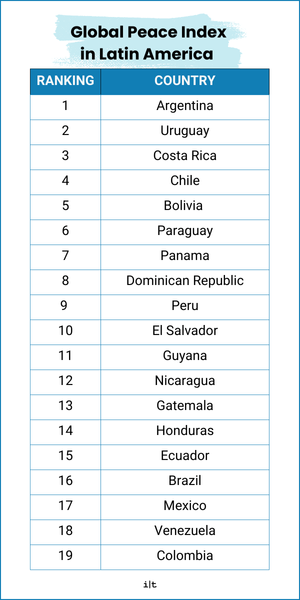
Safety in Latin American ranked.
Unlock Your Residency Options in Latin America
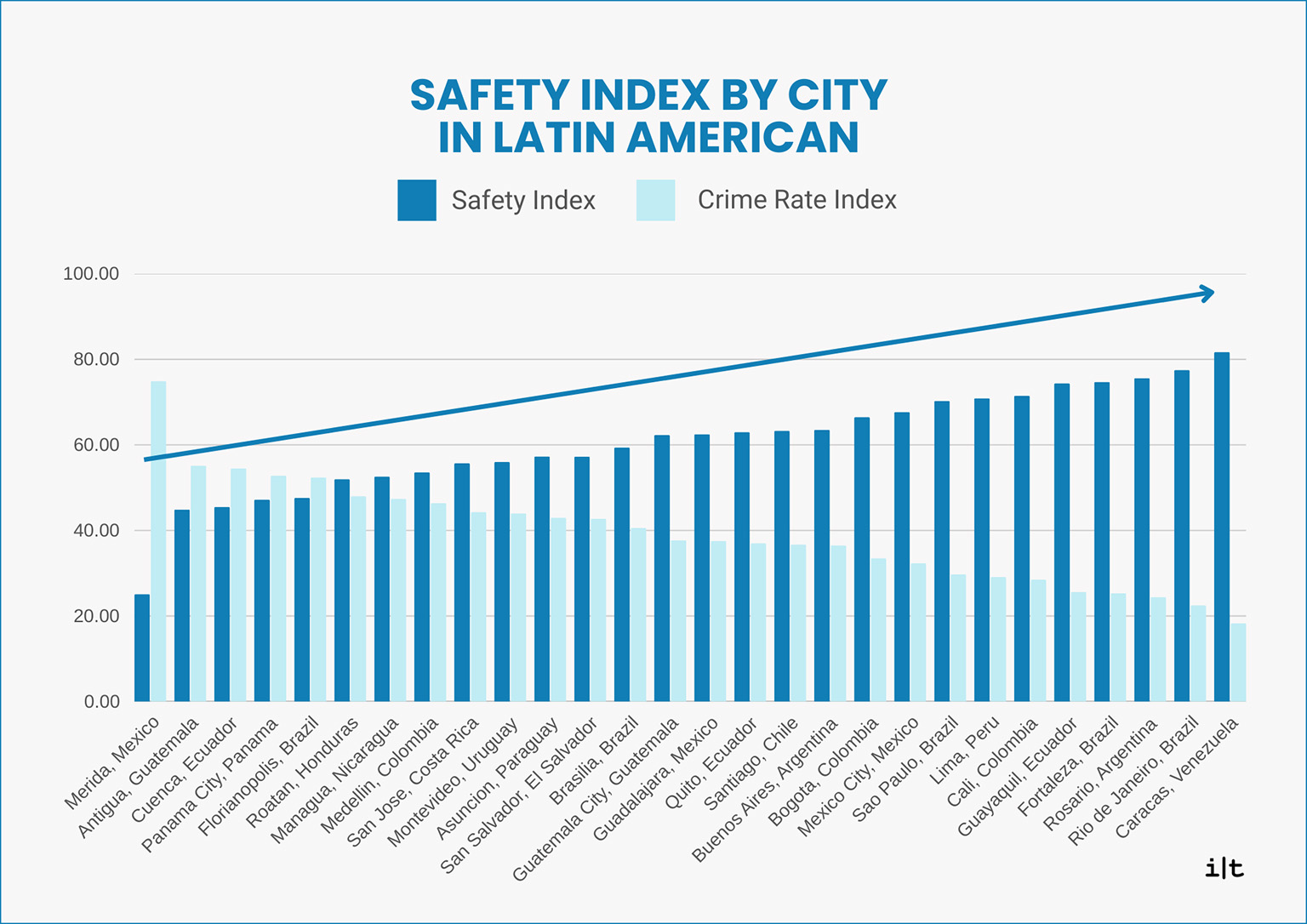
Compare crime rates and safety across key cities in Latin America.
4. What Factors Really Shape Safety in Latin America?
Safety in Latin America is shaped by a wide range of factors, many of which as we mentioned earlier can differ greatly from one country to another.
These elements include political stability, economic conditions, law enforcement effectiveness, social inequality, and the influence of organized crime.
Understanding how these factors come together can help paint a clearer picture of the safety landscape across the region.
For instance, in Mexico, the rise of powerful drug cartels has significantly impacted security, particularly in regions like Guerrero and Sinaloa.
The ongoing battles between criminal organizations and law enforcement have led to heightened violence and instability in these areas.
However, it’s important to note that Mexico is vast, and while some areas are dangerous, others, like Mérida, remain relatively safe and peaceful.
In contrast, countries like Argentina and Uruguay are often regarded as some of the safest in Latin America.
These nations have established stable governments, low crime rates, and strong social policies focused on development.
Uruguay, in particular, benefits from a strong rule of law and a public intolerance for corruption, which has helped foster an environment of security and trust.
Brazil presents a more complex scenario. Major cities like Rio de Janeiro and São Paulo are known for challenges related to gang violence, poverty, and police corruption, but rural areas often experience far less crime. This urban-rural divide is an important factor when evaluating safety in the country.
Similarly, Colombia has seen impressive improvements in safety since the violent days of the 1990s, when drug cartels and insurgent groups ruled much of the country. However, pockets of instability remain in certain regions, as criminal groups continue to hold sway in remote areas.
In Central America, countries like El Salvador and Honduras face some of the highest homicide rates globally, largely due to the dominance of violent street gangs like MS-13 and Barrio 18. Despite these issues, some areas in these countries, such as certain tourist zones, are safer than others.
Meanwhile, Chile and Argentina generally enjoy lower crime rates, but both face growing challenges related to social unrest and occasional violent protests. These dynamic factors contribute to the overall safety picture, making it crucial to research specific areas before traveling or relocating.
5. Security Measures That Make Safety in Latin America Possible
Governments in Latin America have taken various steps to improve safety, especially in popular tourist destinations. In Colombia, the government introduced special “tourist police” (Policía de Turismo) in cities like Bogotá and Cartagena.
These units focus on high-traffic tourist areas, aiming to provide an extra layer of security and assistance to visitors. Peru also has dedicated tourism police, especially in cultural hubs like Lima and Cusco, where they ensure the safety of travelers and respond to any concerns that arise.
6. How Economic Stability Supports Safety in Latin America Safe a Reality
Economic conditions play a crucial role in shaping the safety of a country. Chile stands out in the region for its economic stability, which is linked to its relatively low crime rates compared to its neighbors.
This stability has allowed for substantial investment in infrastructure, improving safety and creating more secure travel conditions.
On the other hand, countries experiencing economic challenges, like Argentina, may see fluctuating crime rates and shifting perceptions of safety, particularly in times of financial instability.
7. Does Cultural Attitudes Shape What “Safety in Latin America” Really Means?
Cultural attitudes towards crime and safety can also affect the overall security situation. Uruguay is an excellent example of a country where there is a strong societal focus on law and order. The country’s relatively low tolerance for corruption and its emphasis on public safety have earned it a reputation as one of the safest destinations in Latin America. Its legal system is robust, and public confidence in law enforcement is high, which contributes to its stable security environment.
8. Why Infrastructure and Tourism Matter for Safety in Latin America
Latin American countries have also made significant strides in improving infrastructure, particularly in areas popular with tourists.
Brazil, for example, invested heavily in its tourism infrastructure ahead of the 2016 Olympics, which included upgrades to public transportation and increased security in major tourist areas like Rio de Janeiro.
However, despite these improvements, the city still faces high crime rates in certain neighborhoods, particularly in gang-controlled favelas. Travelers are encouraged to remain vigilant, especially in areas outside of well-guarded tourist zones.
Where Could You Be Living Next?
Latin American residency options today.
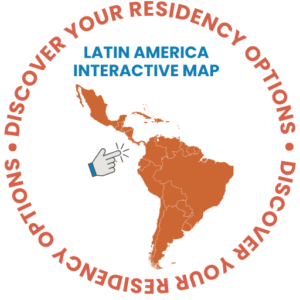
9. Safety in Latin America: Issues Expats Should Know
Latin America is safer than most think. Sure, that doesn’t mean you can run around waving $50 bills in the air and expect everything to run smoothly.
But it also doesn’t mean that within minutes of leaving a Colombian airport you’ll end up in the hands of the dreaded cartels.
Relocating to Latin America offers exciting opportunities, but it’s natural to have concerns about safety. Here are the main dangers often mentioned by those considering a move:
Crime, particularly violent crime, is a major worry for expats. Gang violence, drug trafficking, and organized crime can lead to issues like robbery, assault, and even homicide. While some areas are much safer than others, crime can still be a concern in certain cities. Though Latin America’s overall crime rate can be lower than in the U.S., pockets of violence make some regions riskier than others.
Corruption is a common issue in many Latin American countries, with bribery often being a way to navigate bureaucratic or legal systems. Expats sometimes report being pressured to pay bribes to avoid delays or legal trouble. This, along with inefficiencies in government systems, can create frustration and uncertainty.
Political instability, including protests, civil unrest, or government changes, can make some Latin American countries less appealing to expats. Countries like Venezuela have experienced significant turmoil, leading to economic collapse and widespread violence. Political unpredictability is a valid concern for those seeking a stable environment.
Tropical diseases like dengue, Zika, and chikungunya are common in certain regions of Latin America, posing health risks that aren’t as prevalent in North America or Europe. Additionally, healthcare quality varies across countries, and some expats worry about access to adequate medical care in case of emergencies.
Cultural differences and language barriers can make it difficult for expats to feel settled. Understanding local customs and communicating effectively with locals can be challenging, particularly if you don’t speak the language.
In regions with high levels of organized crime or drug trafficking, kidnapping for ransom or extortion can be a real risk. Countries like Colombia and Mexico, where drug cartels operate, are particularly vulnerable to these threats.
While Latin America offers incredible experiences, beautiful landscapes, rich cultures, and exciting lifestyles, it’s important for expats to understand the potential risks. By being aware of these safety concerns and doing thorough research, you can make an informed decision about whether relocating to the region is right for you.
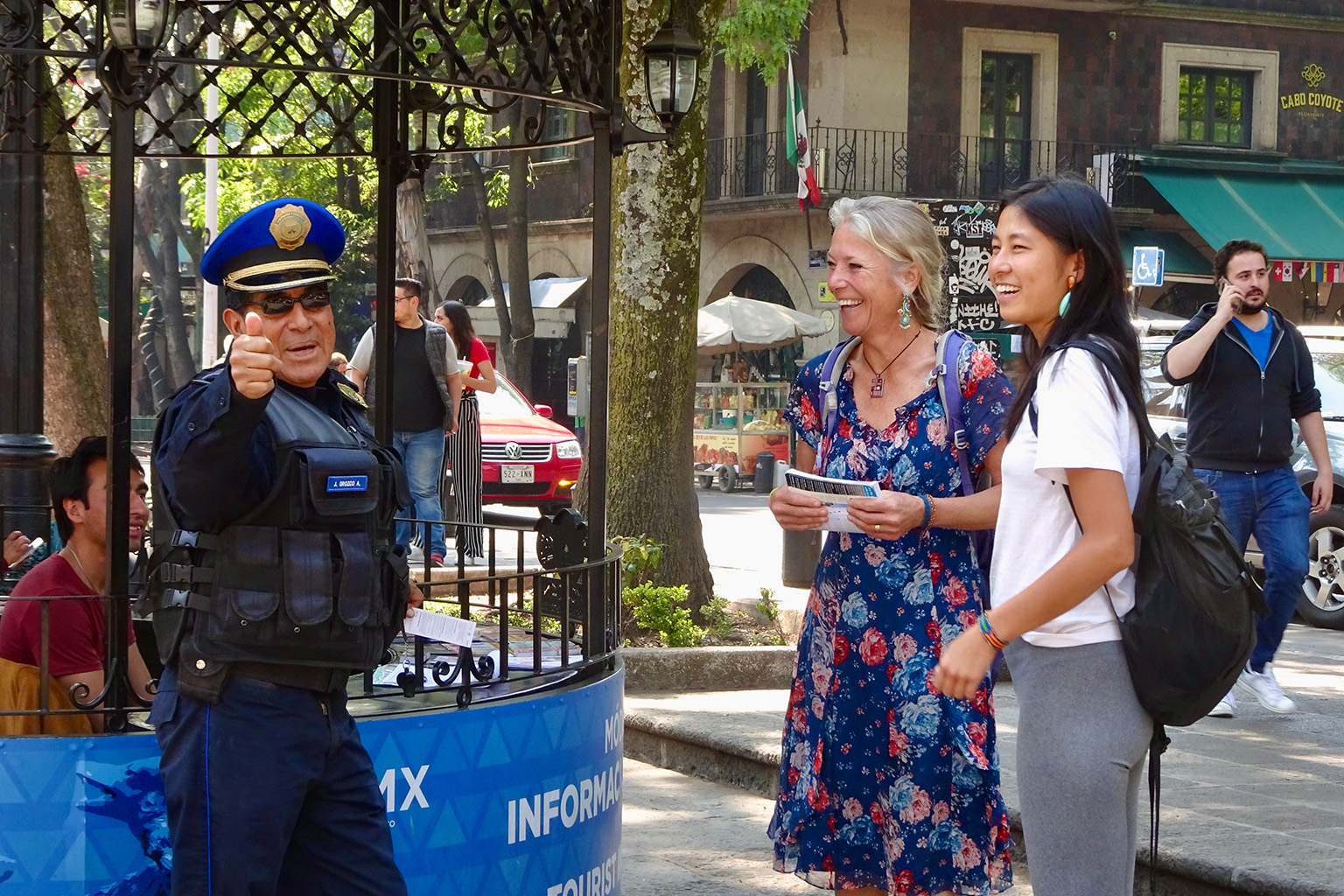
Mexican security personnel assisting two women, highlighting the proactive safety measures in place in Latin American cities. Photo via Flickr
10. Safety in Latin America: How to Assess Your Risk
When it comes to traveling or relocating to Latin America, doing your homework is key to making a safe, informed decision. Here’s how you can ensure you’re fully prepared:
- Research
Start by diving deep into the details of your chosen destination.
Look up crime rates, political stability, ongoing conflicts, and other potential risks. It’s also a great idea to connect with expats already living in the area.
They can offer invaluable insights into daily life and safety, sharing their personal experiences and tips. - Understand Local Crime Trends
Learn about the types of crimes that are common in the area you’re considering.
Some places might have higher crime rates, but knowing the nature of these crimes (e.g., pick-pocketing, or petty theft) can help you assess whether they’re something to genuinely worry about or simply take precautions against. - Know the Region’s Diversity
Remember, Latin America is a huge and diverse region made up of thirty-three countries, each with its own culture, language, and history.
While some countries, like Uruguay, Costa Rica, and Chile, are known for their low crime rates and political stability, others, such as Honduras or Venezuela, may have higher crime rates or political issues.
However, even in countries with a reputation for instability, there are still safe areas and neighborhoods where expats live and thrive. - Don’t Rely Solely on Travel Alerts and the Media
It’s easy to get swept up in travel alerts or sensationalized media reports, but these sources can sometimes be misleading.
Travel advisories may be issued due to political or economic reasons, not always reflecting actual safety risks.
As well, the media has a habit of embellishing dangers to draw attention. If you base your decisions solely on these sources, you might miss some of the amazing experiences Latin America has to offer. - Keep Safety in Perspective
In the safer parts of Latin America, crimes against expats are usually non-violent and more opportunistic, like pick-pocketing or small thefts.
But with a little common sense and street smarts, you can easily avoid these risks.
Basic precautions, such as securing your belongings, avoiding risky areas at night, and staying alert, will go a long way in keeping you safe. - Talk to Other People
One of the best ways to get a realistic sense of safety in your future Latin American home is by connecting with people who have already made the move.
Join expat and nomad groups on social media or online platforms, where you can ask questions and get advice from those who’ve lived in the area you’re considering.
That said, keep in mind that everyone’s experience is different. Responses can vary based on factors like age, gender, family situation, or how long someone has been living there. While their advice is valuable, it’s good to take it with a grain of salt and remember that your experience might be a little different. - Start Learning the Language & Culture
Part of the excitement about moving to Latin America is getting to dive into a whole new language and culture.
But language barriers and cultural differences can also affect your safety, so it’s helpful to start preparing in advance.
If you’re not yet fluent in the local language, learning some basic phrases can make a significant difference in navigating your new surroundings.
Consider taking language classes before you move, and even learning about local customs and cultural norms.
This can help you avoid misunderstandings and feel more comfortable in your new environment.
If you’re moving to a place with a culture quite different from your own, or if the language barrier feels daunting, check for an expat community.
Many areas have thriving expat groups that can offer advice on cultural etiquette and provide emergency help in English if needed. These communities can be an excellent resource as you adjust to your new life abroad.
Where Could You Be Living Next?
Latin American residency options today.


A Colombian woman in traditional dress using her cell phone, blending culture and modern technology in a vibrant Latin American community.
11. Safety in Latin America: Habits and Tips for Everyday Security
When planning a move or visit, it’s important to research which areas are Latin America safe and which may require extra caution.
However, it’s important to take a few safety precautions. Here are some essential tips to help you stay safe:
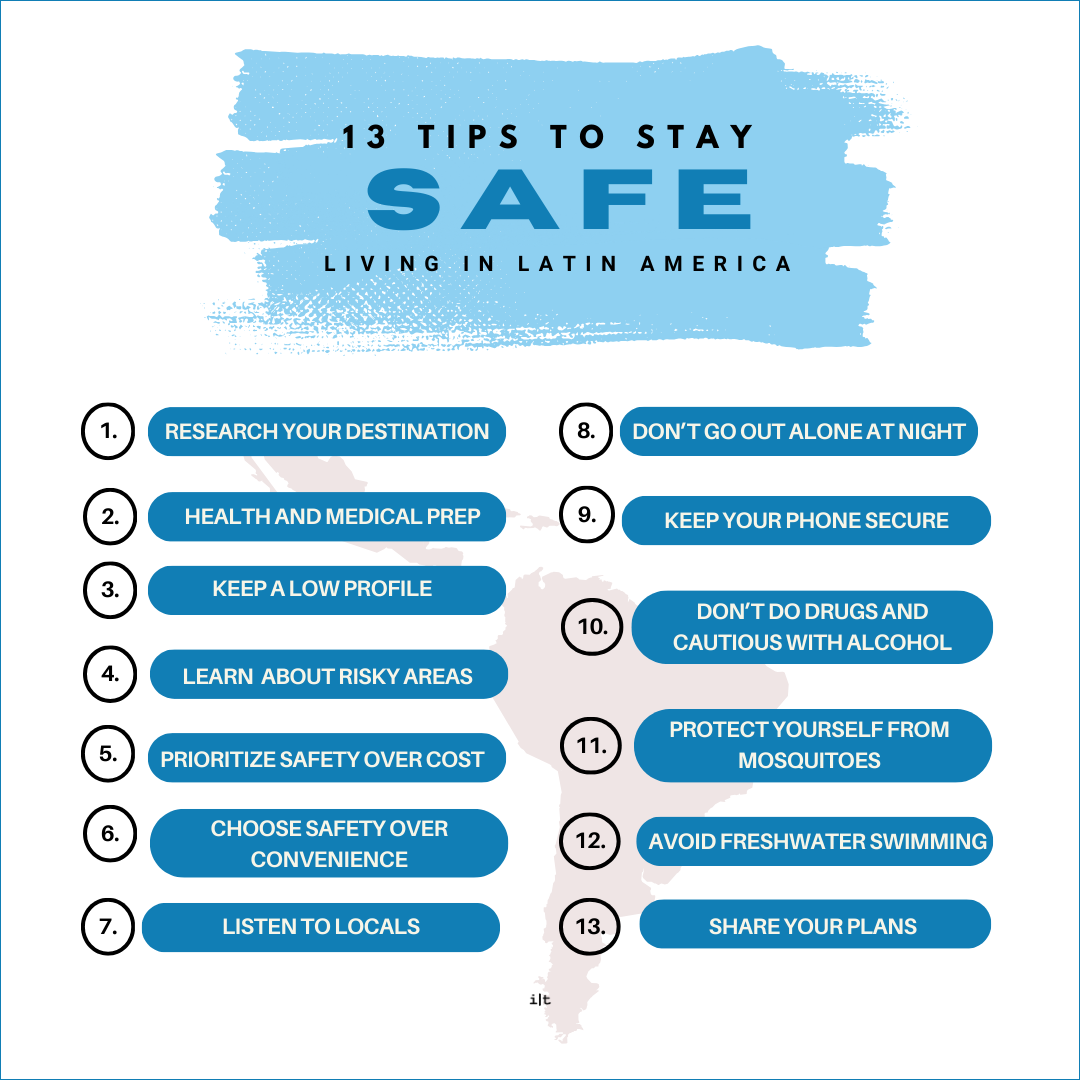
Keep these tips in mind for a safer experience in Latin America.
12. Safety in Latin America: Can You Really Avoid Safety Issues?
While it’s impossible to guarantee 100% safety anywhere, to be safe in Latin America, following basic safety guidelines can significantly reduce your risk of encountering dangerous situations.
The key rule is to never let your guard down—don’t get too comfortable or overconfident, no matter how safe things may seem. By staying vigilant and aware of your surroundings, you’ll avoid many avoidable risks.
That said, it’s important to acknowledge that sometimes, things can still go wrong despite taking every precaution.
Bad luck can strike when you least expect it—whether it’s in the parking lot of a fancy shopping mall or while waiting outside a school. While these incidents are unfortunate, practicing caution can help you minimize exposure to situations that are preventable.
If you’re seeing Latin America through a different lens now, explore the 10 major advantages of living here—you might be surprised what’s possible.
13. Key info Everyone should Know about Safety in Latin America
If you ever find yourself in a dangerous situation, remember this: if you’re confronted by an attacker, don’t resist. They’re after your cash, phone, or other valuables, and it’s always better to hand them over than to risk your life. No material possession is worth more than your safety.
This is part of why Latin America can sometimes have a bad reputation for safety.
Unfortunately, the root of many safety concerns is that some criminals are more focused on getting what they want than on preserving anyone’s life.
While it’s a sad reality, remembering to stay calm and compliant in these situations can help you avoid a much worse outcome.
Rethinking — What Safety in Latin America Really Means
Is Latin America safe?
It’s one of the most common—and complicated—questions people ask before heading south. Latin America offers an incredible adventure, but like any diverse region, it comes with unique safety challenges.
By understanding the safety landscape country by country, busting common myths, and following practical tips, you can greatly reduce your risks and feel more confident as you explore.
Whether you’re planning a short visit or a permanent relocation, asking “Is Latin America safe for me?” is the right place to start.
The truth is, many parts of the region offer a high quality of life, personal freedom, and exciting financial opportunities for expats—if you choose your destination wisely and stay informed about local customs and safety norms.
No destination is 100% risk-free, but with a little research, preparation, and common sense, you can have a secure, rewarding experience.
Learn the language, embrace the culture, and get to know the safety realities on the ground. Latin America is vibrant, welcoming, and full of possibility—especially when you’re ready to navigate it with clarity and confidence.
So, What Does All This Mean for You?
Living in Latin America isn’t about ignoring the risks — it’s about understanding the real picture and making informed choices.
The truth is, safety varies widely depending on where you go, how you live, and the kind of lifestyle you’re after.
Yes, some places come with more caution tape.
But many cities and towns offer a higher sense of safety, stronger community ties, and even more personal freedom than what you’re used to in the U.S., Canada, or Europe.
The takeaway? Safety in Latin America isn’t black and white. It’s local, it’s personal, and it’s manageable — once you know what to expect.
👇 Subscribe below to get the FREE Latin America Residency Map and find out what country you can legally live in.

